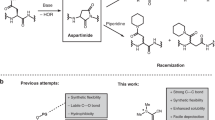Abstract
Purpose. The liquid stability of rhG-CSF was investigated after polyethylene glycol (PEG) with an average molecular weight of 6000 daltons was covalently attached to the N-terminal methionine residue.
Methods. The conjugation methods chosen for modifying the N-terminal residue were alkylation and acylation. The N-terminally PEGylated rhG-CSF conjugates were purified by cation exchange chromatography. The physical characterization methods of SDS-PAGE, endoproteinase peptide mapping, circular dichroism and in-vivo bioassay were used to test for differences between the PEG-rhG-CSF molecules.
Results. Physical characterization indicated no apparent differences in the rhG-CSF molecules that were conjugated with either method. Stability, in liquid at elevated temperatures, of these conjugated molecules indicated that the primary pathway of degradation was aggregation. Conjugation through alkylation offered the distinct advantage of decreasing, by approximately 5 times, the amount of aggregation present as compared to acylation.
Conclusions. We suggest, that the increased stability observed for the molecules utilizing the alkylation conjugation method may be due to the preservation of charge on the alpha amino group of rhG-CSF.
Similar content being viewed by others
REFERENCES
D. Metcalf. The Molecular Biology and Functions of the Granulocyte-Macrophage Colony-Stimulating Factor. Blood 67:257–267 (1986).
K. Welte, E. L. Platzer, H. Lu, J. Gabrilove, R. Mertelsman, and M. A. S. Moore. Purification and Biochemical Characterization of Human Pluripotent Hematopoietic Colony-Stimulating Factor. Proc. Natl. Acad. Sci. USA 82:1526–1530 (1985).
L. M. Souza, T. C. Boone, J. Gabrilove, P. H. Lai, K. M. Zsebo, D. C. Murdock, V. R. Chazin, J. Bruszewski, H. Lu, K. K. Chen, J. Barendt, E. Platzer, M. A. S. Moore, R. Mertlesmann, and K. Welte. Recombinant Human Granulocyte Colony-Stimulationg Factor: Effects on Normal and Leukemic Myeloid Cells. Science 232:61–65 (1986).
A. M. Cohen, K. M. Zsebo, H. Inoue, D. Hines, T. C. Boone, V. R. Chazin, L. Tsai, T. Ritch, and L. M. Souza. In Vivo Stimulation of Granulopoiesis by Recombinant Human Granulocyte Colony-Stimulating Factor. Proc. Natl. Acad. Sci. USA 84:2484–2488 (1987).
Y. Tsutsumi, T. Kihira, S. Tsunoda, N. Okada, Y. Kaneda, Y. Ohsugi, M. Miyake, S. Nakagawa, and T. Mayumi. Polyethylene Glycol Modification of Interleukin-6 Enhances its Thrombopoietic Activity. J. Controlled Release 33:447–451 (1995).
H. F. Gaertner and R. E. Offord. Site-Specific Attachment of Functionalized Poly(Ethylene Glycol) to the Amino Terminus of Proteins. Bioconjugate Chem. 7:38–44 (1996).
Y. Inada, M. Furukawa, H. Sasaki, Y. Kodera, M. Hiroto, H. Nishimura, and A. Matsushima. Trends Biotechnol. 13:86–91 (1995).
S. Davis, A. Abuchowski, Y. K. Park, and F. F. Davis. Alteration of the Circulating Life and Antigenic Properties of Bovine Adenosine Deaminase in Mice by Attachment of Polyethylene Glycol. Clin. Exp. Immunol. 46:649–652 (1981).
O. B. Kinstler. N-Terminally Chemically Modified Protein Composition, and Methods. U.S. Patent Serial No. 08/321,510 (1994).
S. S. Wong. Chemistry of Protein Conjugation and Cross-Linking, CRC Press, Boca Raton, 1991.
U. K. Laemmli. Cleavage of Structural Proteins During the Assembly of the Head of Bacteriophage T4. Nature 227:680–685.
T. L. Kirley. Reduction and Fluorescent Labeling of Cyst(e)ine-Containing Proteins for Subsequent Structural Analyses. Anal. Biochem. 180:231–236 (1989).
M. M. Kurfurst. Detection and Molecular Weight Determination of Polyethylene Glycol-Modified Hirudin by Staining after Sodium Dodecyl Sulfate-Polyacrylamide Gel Electrophoresis. Anal. Biochem. 200:244–248 (1992).
R. Satake-Ishikawa, M. Ishikawa, Y. Okada, M. Kakitani, M. Kawagishi, S. Matsuki, and K. Asano. Chemical Modification of Recombinant Human Granulocyte Colony-Stimulating Factor by Polyethylene Glycol Increases its Biological Activity In Vivo. Cell Structure and Function 17:157–160 (1992).
M. J. Knauf, D. P. Bell, P. Hirtzer, Z-P. Luo, J. D. Young, and N. V. Katre. Relationship of Effective Molecular Size to Systemic Clearance in Rats of Recombinant Interleukin-2 Chemically Modified with Water-Soluble Polymers. JBC 263:15064–15070 (1988).
Author information
Authors and Affiliations
Rights and permissions
About this article
Cite this article
Kinstler, O.B., Brems, D.N., Lauren, S.L. et al. Characterization and Stability of N-terminally PEGylated rhG-CSF. Pharm Res 13, 996–1002 (1996). https://doi.org/10.1023/A:1016042220817
Issue Date:
DOI: https://doi.org/10.1023/A:1016042220817




